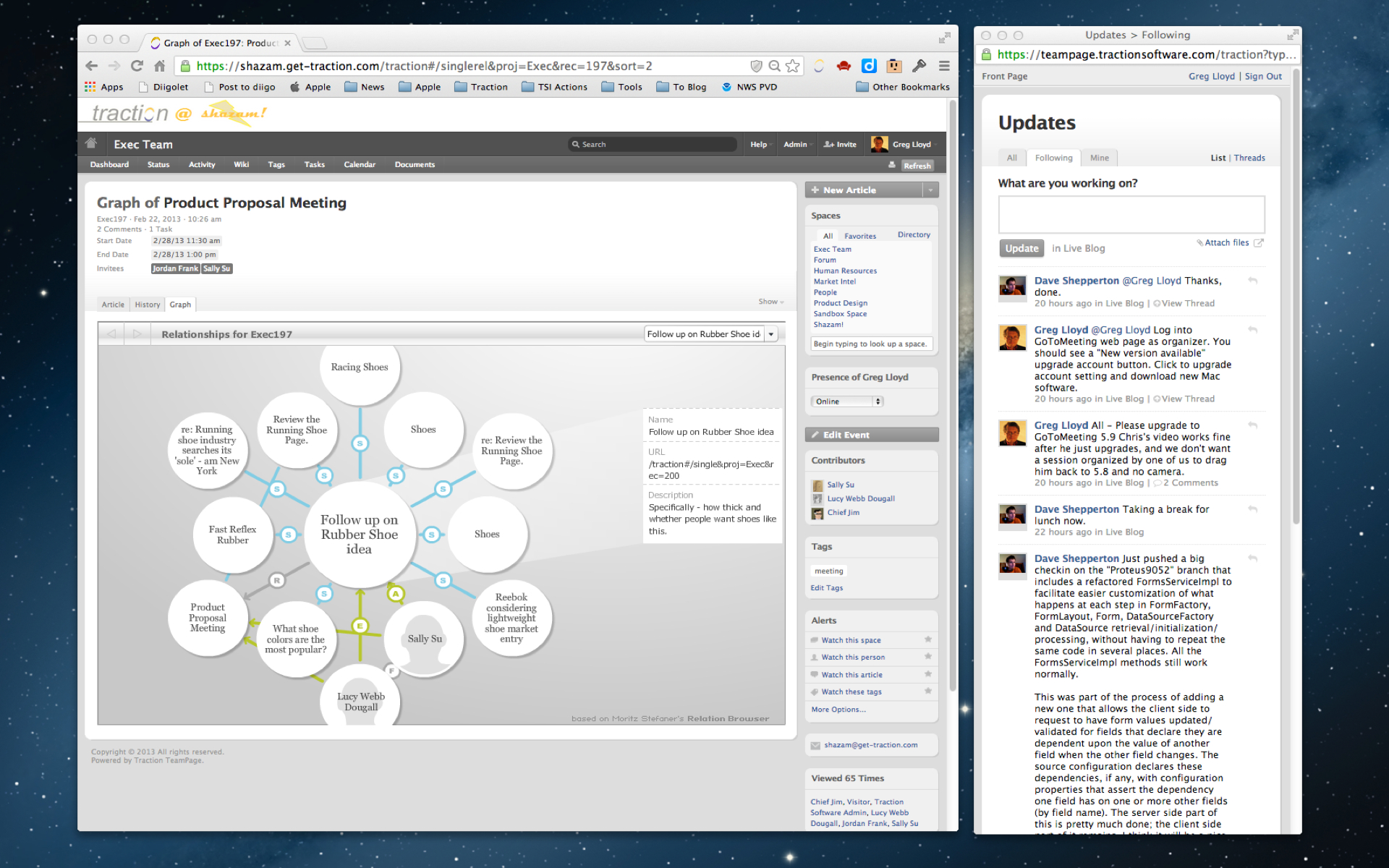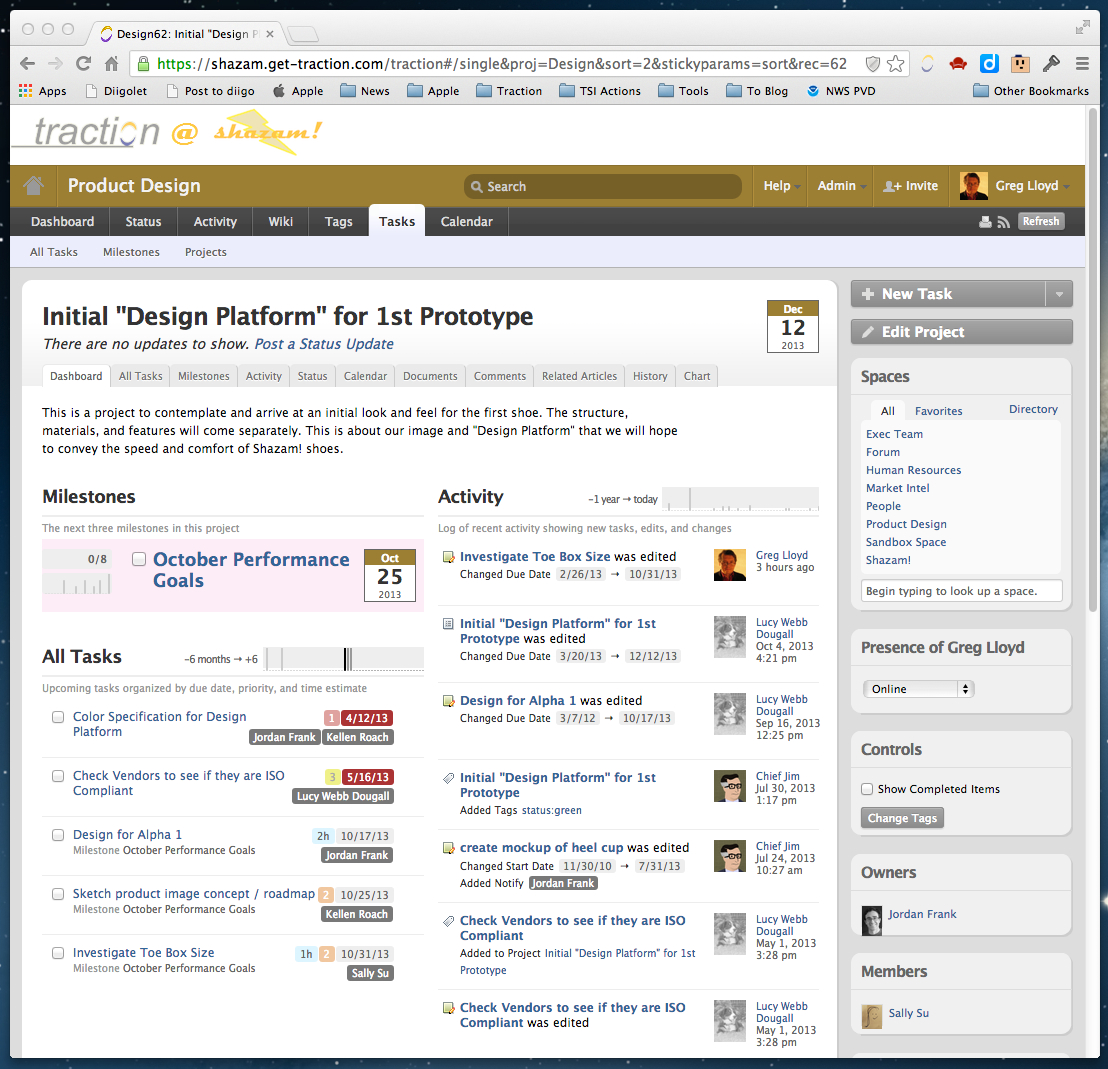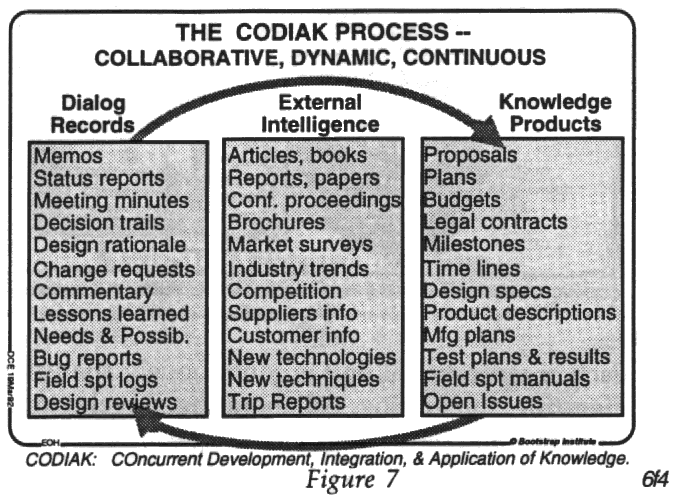The Work Graph Model: TeamPage style
 Justin Rosenstein wrote an excellent option piece for Wired, The Way We Work Is Soul-Sucking, But Social Networks Are Not the Fix. Justin begins: "With Twitter’s recent IPO filing, the most popular graph dominating conversation is the “interest graph.
Justin Rosenstein wrote an excellent option piece for Wired, The Way We Work Is Soul-Sucking, But Social Networks Are Not the Fix. Justin begins: "With Twitter’s recent IPO filing, the most popular graph dominating conversation is the “interest graph.
Work graph defined
".
The upshot of the latter data structure is having all the information we need when we need it. Where the enterprise social graph requires blasting a whole team with messages like “Hey, has anyone started working on this yet?”, we can just query the work graph and efficiently find out exactly who’s working on that task and how much progress they’ve made. Where the enterprise social graph model depends on serendipity, the work graph model routes information with purpose: towards driving projects to conclusions." Justin Rosenstein, Wired 9 Oct 2013
Just so!
TeamPage's work graph
TeamPage watches what you do, and automatically maintains two-way links and relationships as you edit, keeping an accurate version history of everything so you can easily see what changed, when, and who did what.
TeamPage's work graph automatically connects articles, comments, status messages, tasks, milestones, projects, links, shared references, and relationships stored in TeamPage to the TeamPage profile of the person who created, edited or tagged the work, along with a time stamp for the action.
This concept of a work graph is helpful in describing what TeamPage automatically creates and maintains as you work.
But what counts is how TeamPage uses its work graph model to cut clutter, make it much easier to work with people anywhere inside or outside your organization, and make files and records already in IT systems easily accessible to get work done.
The same work graph information is organized and presented two different ways: by person, or by unit of work. This enables TeamPage to show activity feeds, dashboards and calendars of people, linked to the work they created or edited, as well as activity feeds, dashboards, and calendars for specific tasks, projects, and spaces where many people work together.
Dealing with information overload - use the work graph to add context to de-clutter activity streams, navigation and search
You can start by creating a new task directly attached to any paragraph in a TeamPage article. TeamPage links the task and paragraph to make it simple to see what the task is about, in the context of the original meeting notes, spec, or question that kicked off the followup action. You don't need to explain much to define the task, because the task has a direct link to the original source - in context - making it much easier for anyone to come up to speed. Or just click the New Task button to create an independent task.
No more fumbling through your own email, hoping that the person you're working with can find their own copy of the right email or file, or wasting time sending copies to people who just realized they don't have the right stuff. Send a link to any TeamPage task or other item by email or your favorite messaging system when you want to talk about a complicated item during a phone call or video chat.
You can collect a set of tasks to manage as a named Project, and use name Milestone to specify common Start or End dates for related tasks.
You can focus on any specific project or collaboration space and see its dashboard and activity stream without irrelevant noise and clutter. You can also zoom out to a birds eye view which shows a dashboard, activity stream, or calendar view spanning everything you have permission to read. Or click any person's profile to see a dashboard, activity stream, or calendar view focused their work units and actions (clipped to what you're allowed to read).
You can shift your focus whenever you want. You can also watch any article, task, project, or other unit of work and get an automatic email or inline notification when it changes or is commented on. Click on the link in the message to zoom back to that context, or simply reply to the email notification to add a comment in the right place. Or subscribe to TeamPage's email digest for an automatically generated daily summary of activity with links you can click through to read more or reply.
Working with external and internal teams - use permission rules to clip what the work graph lets you see
TeamPage's work graph model includes permissioned access that automatically clips content to show just those work items, relationships, and search results each person is allowed to read.
This makes it simple to use TeamPage for work that can cross boundaries, linking customers, suppliers, partners and internal teams with different permissions to different business activities on the same TeamPage server.
TeamPages' work graph model allows you to put a private comment (or task) in a more private space where it's only visible to a smaller group. For example, an internal team discussion on a customer's question.
Typically each external client has a private space (like separate clients of a law firm), and internal team members have a birds eye view across all clients and most or all internal spaces. TeamPage makes it simple to set up granular access rules for spaces based on individual names, Active Directory, LDAP, or TeamPage group membership.
There's one TeamPage work graph connecting all internal, external, public and private content. Permission based filtering of TeamPage's work graph happens automatically and efficiently at a very deep level whenever activity stream, dashboard, comment thread, or search results are shown to any person. This technology is covered by Traction Software's US Patent 7,593,954.
With TeamPage you don't have to stand up multiple systems and juggle posts, conversations, and tasks across multiple social software silos to work with customers, clients, partners or internal teams working on different activities with different permissions.
Extending the work graph to content on the public Web, Intranet pages, and siloed systems of record.
TeamPage's Social Enterprise Web enables you to share, tag, task or comment on any page your browser can see on the public Web or on your private intranet. Just install TeamPage's Web browser plug-in extension for modern browsers including Internet Explorer, Chrome, Firefox, and Safari.
The Social Enterprise Web also lets you add a TeamPage share button (like Facebook or Google+ share buttons) or comment box (like Disqus) to any public or intranet Web page your organization controls. Comments are stored in TeamPage , and link back to the external Web page, which is treated as part of the TeamPage work graph.
As a bonus, the content of a page linked to TeamPage with the browser plug-in, share button, or comment box is automatically indexed for TeamPage search and drill down navigation.
The Social Enterprise Web makes pages on the public Web or your organization's intranet simple to see, share, find and connect to TeamPage tasks. A task or question on an internal purchase order page can tracked and used part of TeamPage's work graph without complicated or expensive custom integration.
For example, add a TeamPage comment box to an Purchase order page in a Web based ERP system by adding a JavaScript snippet, and see something like this:
Contextual Computing At Work:
"In the world of work, I believe it's incredibly valuable to capture and connect the natural objects of your attention and interest, including tasks, projects, work product, relevant discussion, related references even if you're standing in for Siri or Google Now.
When Mr. Dithers shouts: "Bumstead! Where are we on the Acme Account?", the most timely, frequently discussed and contextually relevant version of Dagwood's Acme tasks, projects and work should pop up near the top of the result list, along with the cloud of tags and people who have touched or talked about tasks, projects and other related to the Acme account and its associated activity streams.
The important requirement is making tasks, projects, pages, discussions and other work products first class sharable, named objects that can be connected to each other and what you're working on, discussed, tagged, tasked, and navigated as well as found using search. Being able to talk about tasks and projects relating to Acme captures one important part of your interest and behavior graph (activity stream), and links these items to the names and behavior of other people working with or discussing the same objects.
The objects and connections made in the context of work are more reliable than connections that need to be inferred from your behavior - and they're available now, including the ability to connect tasks, projects, pages and discussion in TeamPage and files, discussion, email and SQL databases in your external systems of record. They record valuable context for Siri and Google Now when used at work - but there's no reason to wait to get started."
TeamPage examples
How to make your ISO Auditor Smile; And Make Your Professional Life Much Easier Use TeamPage to create, edit, view work instructions from concept to shop floor, tracking every part qualification and compliance issue and notifying everyone when a significant change has occurred so they can read about and adopt the new procedure on their own. Result: a happy and productive team, and a smiling ISO auditor.
Zoom in to focus, zoom out for awareness, bubble up items in the flow of work TeamPage shows dashboard, activity stream, and calendar views of any project, task, milestone when you want to focus on a specific action, or zoom out to get a dashboard that shows a birds eye view of all business activity (based on what each person has permission to read). You can also click to any person's TeamPage profile and see a dashboard, activity stream, or calendar view of all of that person's actions (based on what each person has permission to read).
Contextual Computing At Work Peter Morrison argues that the future or work isn't mobile, it's contextual: "Always-present computers, able to sense the objective and subjective aspects of a given situation, will augment our ability to perceive and act in the moment based on where we are, who we’re with, and our past experiences. These are our sixth, seventh, and eighth senses." The objects and connections made in the context of work are more reliable than connections that need to be inferred from your behavior - and they're available now, including the ability to connect tasks, projects, pages and discussion in TeamPage and files, discussion, email and SQL databases in your external systems of record. They record valuable context for Siri and Google Now when used at work - but there's no reason to wait to get started.
The Future of Work Platforms: Like Jazz When you watch a skilled team in action, it's like watching a great jazz group - there are themes, there is structure, and there are limits, but a team shines in individual excellence combined with coordination, improvisation, innovation, handling exceptions, and seemingly effortless awareness of where others are and where they're headed. The TeamPage action tracking model focuses on making it simple for individuals and teams to plan and coordinate the daily, weekly and monthly activities that drive effective teamwork, with task that can be pinned directly to any paragraph of a TeamPage article or comment.
Extending the fabric of work, or How to Be Emergent A question found in a customer email stored in Exchange, an issue with a new drug application filed in Documentum, a fact in a legacy document stored in SharePoint or a File server S: drive, a record in an SQL database can all be discovered, discussed, tagged, and tasked for follow-up action in TeamPage without converting or importing data from its original source. Systems of record look and act like they are part of the same permission-aware TeamPage fabric used for collaboration, communication, and action tracking in the flow of daily work.
Intertwingled Work Observable work needs to cross silos and systems. Business context makes observable work easy to index and follow. Functionally specialized transactional systems in an organization will likely remain silos of structured information - but market forces will drive vendors to make their content addressable using simple Web standards and services - with consistent authentication and visibility based on context dependent business rules.
A Fabric, not a Platform Apple and Google are competing to build a fabric that connects everything you own and use, working outward from the globally meshed supercomputer people now carry in their pockets. Both are applying deep learning technology to AI assistants, and opening up their AI's and bots to other app, bots, and cloud services reachable through their fabric. This richly connected fabric makes bots useful and AI assistants valuable by teaching them how to identify objects you're talking about as well as what you want done. The same applies at work. Making this happen requires a shift from the traditional definition of a platform to a fabric which makes it possible to connect people and the actionable objects they use, in context
Three primary knowledge domains: intelligence, dialog records, and knowledge products Want to talk about work graphs? Here's how Doug Engelbart dreamed up and build the first hypertext system to link work units and people with the NLS/
Original Traction Product Proposal Original proposal from October 1997, including Traction business case and references, released under Creative Commons license.
Related
Jun 2020 | TeamPage uses Solr for faceted navigation and search - Learn how Solr supports TeamPage's unique work graph model for indexing, visualizing, and using work that crosses boundaries, linking customers, suppliers, partners and internal teams.
Jul 2020 | Transcribing Jim McGee's TUG 2010 Keynote - More Observable Work - With the advent of affordable machine learning technology, automated transcription has become cheap (starting at free), easy, and a new part of the fabric of online life and work. Now a lot of the live conversations and meetings captured in the course of work become more observable and useable. I decided to experiment with Otter.
Dec 2015 | Quality Management, Signature Requirements - Adds Feedback, Non-Conformance, and Corrective Action forms and dashboards to TeamPage's standard support for authoring, sharing and tracking updates to quality and compliance documentation.
Oct 2015 | Personal Worklists, Quick Forms - Track and share what you plan to work on. It's easy to add, rearrange, organize, checkoff and share items on your personal worklist.
July 2015 | TeamPage Live Task Lists - Shared task lists keep everyone in synch on order of execution for tasks as well as planned start and end dates.
May 2015 | TeamPage Bookmarks, interactive filters, and Japanese search improvement - Focus on what interests you; return to any filtered or standard view with one click.
March 2015 | TeamPage 6.1 Burn-up charts, interactive tables, SDK extensions - Track progress and summarize activity in context.
Dec 2014 | TeamPage @ Mentions - Bring an article, comment, status post or other object to someone's attention by typing their name.
July 2014 | TeamPage Notifications - Inline and email notifications. Watch what interests you, reply inline or by email.



 I18N ERROR: @tsiskin#footer_RSS_Feed
I18N ERROR: @tsiskin#footer_RSS_Feed